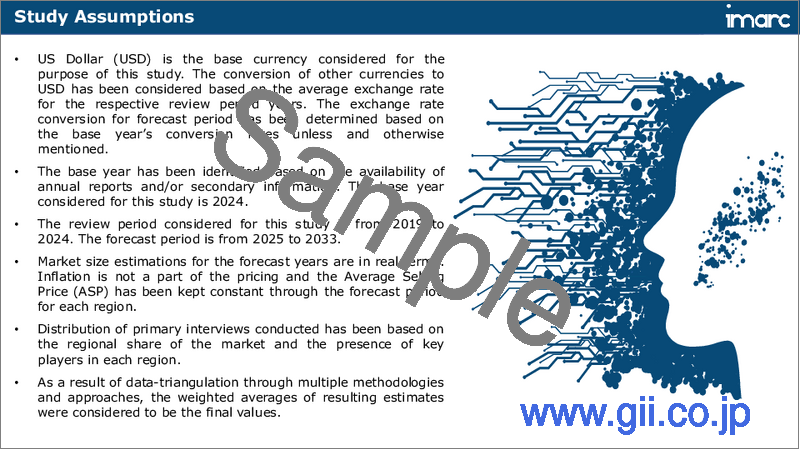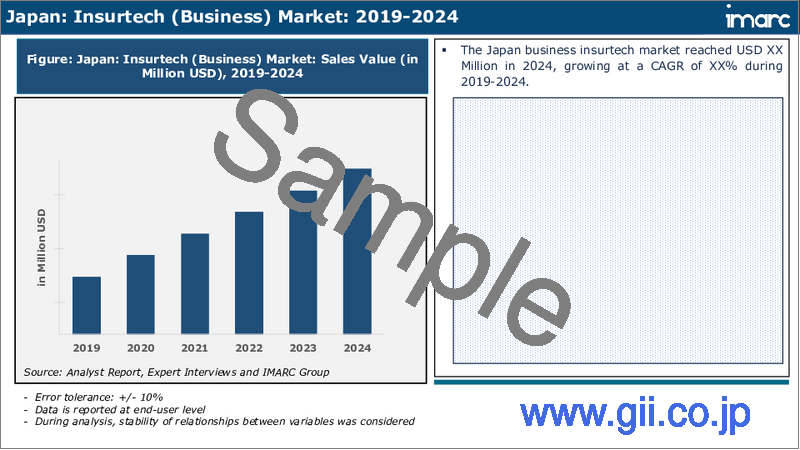|
|
市場調査レポート
商品コード
1746930
日本のインシュアテック市場の分析:種類別、サービス別、テクノロジー別、地域別(2025~2033年)Japan Insurtech Market Report by Type, Service, Technology, and Region 2025-2033 |
||||||
カスタマイズ可能
|
|||||||
| 日本のインシュアテック市場の分析:種類別、サービス別、テクノロジー別、地域別(2025~2033年) |
|
出版日: 2025年06月02日
発行: IMARC
ページ情報: 英文 121 Pages
納期: 5~7営業日
|
全表示
- 概要
- 目次
日本のインシュアテックの市場規模は2024年に4億3,260万米ドルに達しました。今後、IMARC Groupは、同市場が2033年までに65億2,950万米ドルに達し、2025~2033年の成長率(CAGR)は32.5%に達すると予測しています。サイバーセキュリティ対策の普及と消費者行動、デジタルプラットフォームへの個人志向の高まりが、主に市場成長を牽引しています。
当レポートで扱う主な質問
- 日本のインシュアテック市場はこれまでどのように推移し、今後どのように推移するのか?
- COVID-19が日本のインシュアテック市場に与えた影響は?
- 日本のインシュアテック市場の種類別の内訳は?
- 日本のインシュアテック市場のサービス別の内訳は?
- 日本のインシュアテック市場のテクノロジー別の内訳は?
- 日本のインシュアテック市場のバリューチェーンにおける各ステージとは?
- 日本のインシュアテックの主要な促進要因と課題は?
- 日本のインシュアテック市場の構造と主要企業は?
- 日本のインシュアテック市場における競合の程度は?
目次
第1章 序文
第2章 分析範囲・手法
- 分析目的
- ステークホルダー
- データソース
- 市場推定
- 分析手法
第3章 エグゼクティブサマリー
第4章 日本のインシュアテック市場:概要
- 概要
- 市場力学
- 業界動向
- 競合情報
第5章 日本のインシュアテック市場の情勢
- 過去・現在の市場動向(2019~2024年)
- 市場予測(2025~2033年)
第6章 日本のインシュアテック市場:種類別の内訳
- 自動車
- 業務
- 健康
- 住宅
- 専門
- 旅行
- その他
第7章 日本のインシュアテック市場:サービス別の内訳
- コンサルティング
- サポート・整備
- マネージドサービス
第8章 日本のインシュアテック市場:テクノロジー別の内訳
- ブロックチェーン
- クラウドコンピューティング
- IoT
- 機械学習
- ロボアドバイザー
- その他
第9章 日本のインシュアテック市場:競合情勢
- 概要
- 市場構造
- 市場企業のポジショニング
- 主要な成功戦略
- 競合ダッシュボード
- 企業評価象限
第10章 主要企業のプロファイル
第11章 日本のインシュアテック市場:業界分析
- 促進要因・抑制要因・機会
- ポーターのファイブフォース分析
- バリューチェーン分析
第12章 付録
Japan insurtech market size reached USD 432.6 Million in 2024. Looking forward, IMARC Group expects the market to reach USD 6,529.5 Million by 2033, exhibiting a growth rate (CAGR) of 32.5% during 2025-2033. The widespread adoption of cybersecurity measures and consumer behavior, along with the growing inclination among individuals towards digital platforms, is primarily driving the market growth.
An insurtech, short for insurance technology, constitutes a subset within the insurance sector that employs technology to revolutionize and enhance the conventional insurance paradigm. It harnesses technological breakthroughs like artificial intelligence, data analysis, and cloud computing to optimize operational efficiency, individualize insurance products, and simplify customer interactions. These companies operate by deploying digital interfaces, automation, and advanced algorithms to offer swifter insurance quotes, more precise risk evaluations, and a seamless claims handling procedure. Insurtech is dedicated to various dimensions of the insurance realm, encompassing underwriting, the management of claims, and customer engagement, thus crafting tailor-made solutions that align with specific requirements.
Japan Insurtech Market Trends:
The insurtech market in Japan is undergoing significant transformation, blending the country's rich insurance industry heritage with cutting-edge technological advancements. Japan's insurance sector, one of the world's largest, is embracing insurtech to optimize operations and enhance customer experiences. This market is characterized by innovative startups and established insurers that are leveraging technology to disrupt and improve traditional insurance practices. Several factors are driving the growth of insurtech in Japan. Firstly, the country's aging population and changing demographics necessitate innovative insurance solutions to cater to evolving healthcare and retirement needs. Insurtech companies are stepping in to fill these gaps with personalized and tech-driven insurance products. Secondly, Japan's robust regulatory environment encourages the integration of insurtech, ensuring data security and consumer protection while promoting innovation. Furthermore, the nation's high internet and smartphone penetration rates make it conducive for insurtech firms to reach and engage with customers digitally. Moreover, insurtech is optimizing various aspects of the insurance process in Japan, from underwriting and policy issuance to claims management and customer service. This, in turn, is expected to fuel the regional market in the coming years.
Japan Insurtech Market Segmentation:
Type Insights:
- Auto
- Business
- Health
- Home
- Specialty
- Travel
- Others
Service Insights:
- Consulting
- Support and Maintenance
- Managed Services
Technology Insights:
- Blockchain
- Cloud Computing
- IoT
- Machine Learning
- Robo Advisory
- Others
Competitive Landscape:
The market research report has also provided a comprehensive analysis of the competitive landscape. Competitive analysis such as market structure, key player positioning, top winning strategies, competitive dashboard, and company evaluation quadrant has been covered in the report. Also, detailed profiles of all major companies have been provided.
Key Questions Answered in This Report:
- How has the Japan insurtech market performed so far and how will it perform in the coming years?
- What has been the impact of COVID-19 on the Japan insurtech market?
- What is the breakup of the Japan insurtech market on the basis of type?
- What is the breakup of the Japan insurtech market on the basis of service?
- What is the breakup of the Japan insurtech market on the basis of technology?
- What are the various stages in the value chain of the Japan insurtech market?
- What are the key driving factors and challenges in the Japan insurtech?
- What is the structure of the Japan insurtech market and who are the key players?
- What is the degree of competition in the Japan insurtech market?
Table of Contents
1 Preface
2 Scope and Methodology
- 2.1 Objectives of the Study
- 2.2 Stakeholders
- 2.3 Data Sources
- 2.3.1 Primary Sources
- 2.3.2 Secondary Sources
- 2.4 Market Estimation
- 2.4.1 Bottom-Up Approach
- 2.4.2 Top-Down Approach
- 2.5 Forecasting Methodology
3 Executive Summary
4 Japan Insurtech Market - Introduction
- 4.1 Overview
- 4.2 Market Dynamics
- 4.3 Industry Trends
- 4.4 Competitive Intelligence
5 Japan Insurtech Market Landscape
- 5.1 Historical and Current Market Trends (2019-2024)
- 5.2 Market Forecast (2025-2033)
6 Japan Insurtech Market - Breakup by Type
- 6.1 Auto
- 6.1.1 Overview
- 6.1.2 Historical and Current Market Trends (2019-2024)
- 6.1.3 Market Forecast (2025-2033)
- 6.2 Business
- 6.2.1 Overview
- 6.2.2 Historical and Current Market Trends (2019-2024)
- 6.2.3 Market Forecast (2025-2033)
- 6.3 Health
- 6.3.1 Overview
- 6.3.2 Historical and Current Market Trends (2019-2024)
- 6.3.3 Market Forecast (2025-2033)
- 6.4 Home
- 6.4.1 Overview
- 6.4.2 Historical and Current Market Trends (2019-2024)
- 6.4.3 Market Forecast (2025-2033)
- 6.5 Specialty
- 6.5.1 Overview
- 6.5.2 Historical and Current Market Trends (2019-2024)
- 6.5.3 Market Forecast (2025-2033)
- 6.6 Travel
- 6.6.1 Overview
- 6.6.2 Historical and Current Market Trends (2019-2024)
- 6.6.3 Market Forecast (2025-2033)
- 6.7 Others
- 6.7.1 Historical and Current Market Trends (2019-2024)
- 6.7.2 Market Forecast (2025-2033)
7 Japan Insurtech Market - Breakup by Service
- 7.1 Consulting
- 7.1.1 Overview
- 7.1.2 Historical and Current Market Trends (2019-2024)
- 7.1.3 Market Forecast (2025-2033)
- 7.2 Support and Maintenance
- 7.2.1 Overview
- 7.2.2 Historical and Current Market Trends (2019-2024)
- 7.2.3 Market Forecast (2025-2033)
- 7.3 Managed Services
- 7.3.1 Overview
- 7.3.2 Historical and Current Market Trends (2019-2024)
- 7.3.3 Market Forecast (2025-2033)
8 Japan Insurtech Market - Breakup by Technology
- 8.1 Blockchain
- 8.1.1 Overview
- 8.1.2 Historical and Current Market Trends (2019-2024)
- 8.1.3 Market Forecast (2025-2033)
- 8.2 Cloud Computing
- 8.2.1 Overview
- 8.2.2 Historical and Current Market Trends (2019-2024)
- 8.2.3 Market Forecast (2025-2033)
- 8.3 IoT
- 8.3.1 Overview
- 8.3.2 Historical and Current Market Trends (2019-2024)
- 8.3.3 Market Forecast (2025-2033)
- 8.4 Machine Learning
- 8.4.1 Overview
- 8.4.2 Historical and Current Market Trends (2019-2024)
- 8.4.3 Market Forecast (2025-2033)
- 8.5 Robo Advisory
- 8.5.1 Overview
- 8.5.2 Historical and Current Market Trends (2019-2024)
- 8.5.3 Market Forecast (2025-2033)
- 8.6 Others
- 8.6.1 Historical and Current Market Trends (2019-2024)
- 8.6.2 Market Forecast (2025-2033)
9 Japan Insurtech Market - Competitive Landscape
- 9.1 Overview
- 9.2 Market Structure
- 9.3 Market Player Positioning
- 9.4 Top Winning Strategies
- 9.5 Competitive Dashboard
- 9.6 Company Evaluation Quadrant
10 Profiles of Key Players
- 10.1 Company A
- 10.1.1 Business Overview
- 10.1.2 Product Portfolio
- 10.1.3 Business Strategies
- 10.1.4 SWOT Analysis
- 10.1.5 Major News and Events
- 10.2 Company B
- 10.2.1 Business Overview
- 10.2.2 Product Portfolio
- 10.2.3 Business Strategies
- 10.2.4 SWOT Analysis
- 10.2.5 Major News and Events
- 10.3 Company C
- 10.3.1 Business Overview
- 10.3.2 Product Portfolio
- 10.3.3 Business Strategies
- 10.3.4 SWOT Analysis
- 10.3.5 Major News and Events
- 10.4 Company D
- 10.4.1 Business Overview
- 10.4.2 Product Portfolio
- 10.4.3 Business Strategies
- 10.4.4 SWOT Analysis
- 10.4.5 Major News and Events
- 10.5 Company E
- 10.5.1 Business Overview
- 10.5.2 Product Portfolio
- 10.5.3 Business Strategies
- 10.5.4 SWOT Analysis
- 10.5.5 Major News and Events
11 Japan Insurtech Market - Industry Analysis
- 11.1 Drivers, Restraints, and Opportunities
- 11.1.1 Overview
- 11.1.2 Drivers
- 11.1.3 Restraints
- 11.1.4 Opportunities
- 11.2 Porters Five Forces Analysis
- 11.2.1 Overview
- 11.2.2 Bargaining Power of Buyers
- 11.2.3 Bargaining Power of Suppliers
- 11.2.4 Degree of Competition
- 11.2.5 Threat of New Entrants
- 11.2.6 Threat of Substitutes
- 11.3 Value Chain Analysis





